药学英语
- 格式:ppt
- 大小:69.50 KB
- 文档页数:31
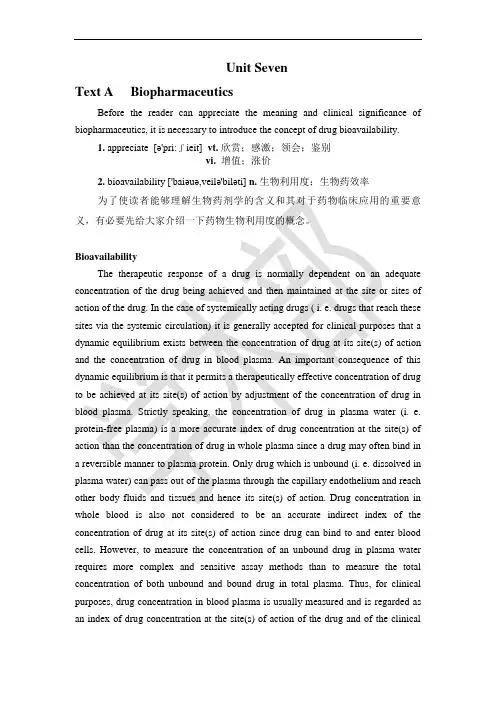
Unit SevenText A BiopharmaceuticsBefore the reader can appreciate the meaning and clinical significance of biopharmaceutics, it is necessary to introduce the concept of drug bioavailability.1. appreciate [ə'pri:ʃ ieit] vt.欣赏;感激;领会;鉴别vi.增值;涨价2. bioavailability ['baiəuə,veilə'biləti] n.生物利用度;生物药效率为了使读者能够理解生物药剂学的含义和其对于药物临床应用的重要意义,有必要先给大家介绍一下药物生物利用度的概念。
BioavailabilityThe therapeutic response of a drug is normally dependent on an adequate concentration of the drug being achieved and then maintained at the site or sites of action of the drug. In the case of systemically acting drugs ( i. e. drugs that reach these sites via the systemic circulation) it is generally accepted for clinical purposes that a dynamic equilibrium exists between the concentration of drug at its site(s) of action and the concentration of drug in blood plasma. An important consequence of this dynamic equilibrium is that it permits a therapeutically effective concentration of drug to be achieved at its site(s) of action by adjustment of the concentration of drug in blood plasma. Strictly speaking, the concentration of drug in plasma water (i. e. protein-free plasma) is a more accurate index of drug concentration at the site(s) of action than the concentration of drug in whole plasma since a drug may often bind in a reversible manner to plasma protein. Only drug which is unbound (i. e. dissolved in plasma water) can pass out of the plasma through the capillary endothelium and reach other body fluids and tissues and hence its site(s) of action. Drug concentration in whole blood is also not considered to be an accurate indirect index of the concentration of drug at its site(s) of action since drug can bind to and enter blood cells. However, to measure the concentration of an unbound drug in plasma water requires more complex and sensitive assay methods than to measure the total concentration of both unbound and bound drug in total plasma. Thus, for clinical purposes, drug concentration in blood plasma is usually measured and is regarded as an index of drug concentration at the site(s) of action of the drug and of the clinicaleffects of the drug. However, it should be realized that this is a simplification and may not always be valid. Indeed one should not draw inferences about the clinical effects of a drug from its plasma concentration until it has been established that the two are consistently correlated. It has been assumed that the plasma drug concentration is directly proportional to the clinical effect of that drug.1. systemically [ sistə'mætikəli ] adv.有系统地,有组织地,有条理地,全身地systemic [si'stemik; -'sti:-] adj.系统的;体系的;全身的2. purpose ['pə:pəs] n.目的;用途;意志vt. 决心;企图;打算3. dynamic equilibrium [dai'næmik] [,i:kwi'libriəm] 动态平衡;动力平衡4. plasma ['plæzmə] n.等离子体;血浆5. reversible [ri'və:səbl] adj.可逆的;可撤消的;可反转的n. 双面布料6. capillary endothelium [kə'piləri, 'kæpi-] [,endəu'θi:liəm] 毛细血管内皮7. assay [ə'sei] n.化验;试验vt.分析;化验;尝试vi.鉴定;经检验证明内含成分8. simplification [,sɪmpləfə'keʃən] n.简单化;单纯化9. valid ['vælid] adj.有效的,有根据的;正当的10. draw inferences ['infərəns] 作出推论11. consistently [kən'sistəntli] adv.一贯地;一致地;坚实地12. proportional to [prə'pɔ:ʃənəl] 与……相称,与……成比例通常情况下,药物达到其作用部位、并维持足够的药物浓度,才能发挥疗效。
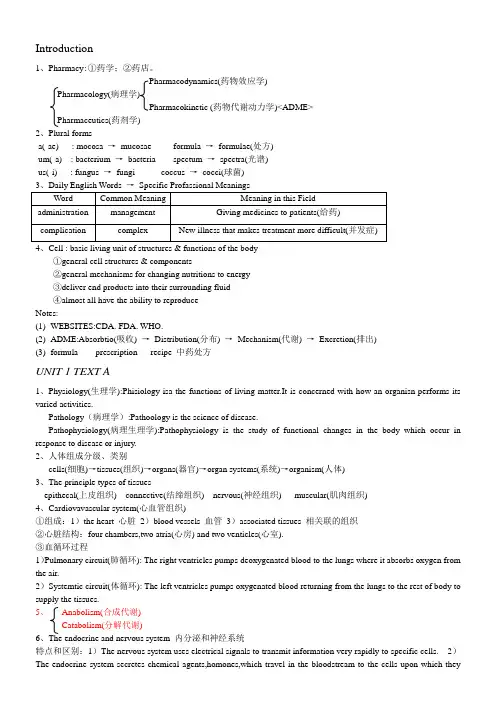
Introduction1、Pharmacy:①药学;②药店。
Pharmacodynamics(药物效应学)Pharmacology(病理学)Pharmacokinetic (药物代谢动力学)<ADME>Pharmaceutics(药剂学)2、Plural forms-a(-ae) : mocosa →mucosae formula →formulae(处方)-um(-a) : bacterium →bacteria spectum →spectra(光谱)-us(-i) : fungus →fungi coccus →cocci(球菌)4、Cell : basic living unit of structures & functions of the body①general cell structures & components②general mechanisms for changing nutritions to energy③deliver end products into their surrounding fluid④almost all have the ability to reproduceNotes:(1)WEBSITES:CDA. FDA. WHO.(2)ADME:Absorbtio(吸收) →Distribution(分布) →Mechanism(代谢) →Excretion(排出)(3)formula prescription recipe 中药处方UNIT 1 TEXT A1、Physiology(生理学):Phisiology isa the functions of living matter.It is concerned with how an organisn performs its varied activities.Pathology(病理学):Pathoology is the science of disease.Pathophysiology(病理生理学):Pathophysiology is the study of functional changes in the body which occur in response to disease or injury.2、人体组成分级、类别cells(细胞)→tissues(组织)→organs(器官)→organ systems(系统)→organism(人体)3、The principle types of tissuesepithecal(上皮组织) connective(结缔组织) nervous(神经组织) muscular(肌肉组织)4、Cardiovavascular system(心血管组织)①组成:1)the heart 心脏2)blood vessels 血管3)associated tissues 相关联的组织②心脏结构:four chambers,two atria(心房) and two venticles(心室).③血循环过程1)Pulmonary circuit(肺循环): The right ventricles pumps deoxygenated blood to the lungs where it absorbs oxygen from the air.2)Systemtic circuit(体循环): The left ventricles pumps oxygenated blood returning from the lungs to the rest of body to supply the tissues.5、Anabolism(合成代谢)Catabolism(分解代谢)6、内分泌和神经系统特点和区别:1)The nervous system uses electrical signals to transmit information very rapidly to specific cells. 2)The endocrine system secretes chemical agents,homones,which travel in the bloodstream to the cells upon which theyexert a regulary effect.7、Homeostasis (稳态):①定义:1)The process of stabilization of the internal environment/2)Maintanance of relatively constant chemical/physical conditions of the internal environment[stabl e≠rigidity]②作用:Homeostasis regulates its internal environment and tends to maintain a stable,constant condition of properties like temperature or pH.8、How to regulate the internal environment(one example)P5[Taking one example,the beating``````]Notes:Body Fluids 体液Extracellular fluid (ECF) 细胞外液→internal environment(内环境)Intracellular fluid (ICF) 细胞内液UNIT 3 TEXT B1、Antibiotic: chemical produced by a microorganism that kills or inhibits the growth of another microorganism.分类:①(?) 1)Antibacterial antibiotics(抗菌抗生素) 2)Antineoplastic antibiotics(抗癌抗生素)②1)cell wall inhibitors2)protein synthesis inhibitors3)folic acid inhibitors4)DNA synthesis inhibitors5)RNA synthesis inhibitors2、cross-infection(交叉感染)Super-infection(双重感染)3、不良反应:1)anaphylactic shock(过敏性休克)2)gastrointestinal disorder 肠胃失调;sore mouth 口腔溃疡;cramps 痉挛;diarrhea 腹泻;anal itch 肛痒UNIT 4 TEXT B1、Adverse drug reactions(ADR):unwanted effects caused by normal therapeutic does.2、Type A 和Type B 的区别1)Type A:①a consequence of the drug’s main pharmacological effect/predictable from pharmacological(药理学的) effect;②dose-related and usually mild;③usually due to incorrect dosage.2)Type B:①not predictable from the drug’s main pharmacological action;②not dose-related and severe with considerable mortality(死亡率);③The underlying pathophysiology (潜在的病理)of type B reactions is poorly if at all understood,and often has a genetic or immunological (免疫学的)basis;④occur infrequently(罕见的).3、Type C、D、E的概念Type C :continuous reactions due to long-term drug useType D :delayed reactionsType E :end-of-use reactions3、Phase I/II/III Trials①Early(phase I/II) tials are important for assessing the tolerability and dose-response relationship of new therapeutic agents.②Phase III clinical trials can establish the incidence of common adverse reactions and relate this to therapeutic benefit. UNIT 5 TEXT B1、Lead compounds(先导物)①定义②特点2、Strategies in the Search for New Lead Compounds①②③④UNIT 7 TEXT B1、Controlled-release Technology 控释技术分类:①biodegradable polymers(可生物降解的聚合物);②maze escape(迷宫逃脱);③transmucosal delivery(透膜传递系统);④osmotic devices(渗透装置);⑤liposomes(脂质体)2、Liposomes 脂质体P1003、脂质体被机体视为外来入侵物应如何解决?P101UNIT 8 TEXT A1、Analysis chemistry(分析化学) is concerned with the chemical characterization of matter and the answers to two important questions:what is it qualitative and how much is it quantative.2、Qualitative and Quantitative Analyses[pl]区别:①Qualitative analyses deal with the identification of elements(元素),ions(离子),or compounds(化合物) present ina sample;②Quantitative analses deal with the determonation of how much of one or more constituents(成分) is present.4、P110(In comparing qualitative versus quantitative analysis``````)介绍分析化学的应用:奥运会对违禁药品(bannedsubstances)的检验等UNIT 10 TEXT A1、USP(the United States Pharmacopoeia)美国药典内容: ①drugs; ②biologics; ③medical devices(医疗器械);④dietary supplements(补充剂);⑤compounded preparations(联合用药).UNIT 11 TEXT A1、P161 (The package insert,by legal definition``````)2、P162(American Academy of Pediatrics``````)Off-label useUNIT 12 TEXT A1、Drug development aims to produce a novel therapeutic agent which is superior in efficacy to existing remedies andwhich causes less frequent or less severe adverse effects.2、Drug development strategies①Random screening(随机筛选)②molecular roulette(分子轮盘赌);③Minor structural cahnges in existing agents(在已有药物上做小的改变)④Programmed basic research with synthesis of specific chemical(有计划地研究特定化合物合成)⑤Clinical observation of drug action in practice(临床实验观察药物作用)3、LD50 : the dose that kills 50% of animals(半数致死量)ED50: the dose causing 50% of maximum pharmacological response(半数有效量)治疗指数Therapeutic index(Ti) = LD50/ED504、三致反应:teratogenic effect 致畸mutagenicity 致突变carcinogenicity 致癌5、Enteral(经肠的) oral — swallowingThe route of administration intramuscular(IM) 肌肉注射Parenteral(非经肠的)subcutaneous(SC) 皮下注射Intravenous(IV) 静脉注射Intraperitoneal(IP) 腹腔注射6、Experimental pharmacology(实验期药理学)mouse(小鼠)→rat(大鼠)→hare(兔子)→dog →monkeyTEXT B1、Clinical EvaluationPhase 1 : determine whether the drug can be given to man without serious symptoms or toxicity, and whether it has the desired(强烈的) pharmacological effects.Phase 2 : determine whether the new drug has the desired effect on patients with the appropriate disease.Phase 3 : progression to large scale clinical trials to determine how the new drug compares in clinical practice with existing remedies,and to establish its profile of action and frequency of adverse effects.Phase 4 : collect the information on low-frequency adverse effects.UNIT 14 TAXT A1、A good number of products found in the grocery or drug store are regulated by the FDA.(①food;②drugs;③cosmetics;④the use of radiological products;⑤all of these products are honestly and informatively labeled.)2、FDA’s goal is to ensure industry’s compliance with federal laws regulating products in commerce.UNIT 14 TAXT B1、FDA审评新药的根本原则:the benefits outweigh the risks(收益风险比)2、1938年法案:Providing evidence of safety before marketing was first required.(第一次规范性规定安全性证明)1962年法案:It was first required to show a drug’s effectiveness before marketing.(反应停事件为背景,药物上市前的有效性提出法案)2、新药研发Lead conpound →NCEs →animals →clinical trials →NDA新药申请:IND(investigational new drug application): before the clinical trialsNDA(new drug applications): after the phase III for marketing3、Review Time: always longer than 180 workdays.Average approval time is more like 2 years.4、Why the reviewer purge trade secrets from documents requested under the Freedom of Information Act?5、Priorities1)AIDS drugs; 2) drugs that offer a significant medical advance over existing therapies for any other disease.6、be approved for marketingFinal Actions: be approvable provided minor changes are madeBe not approvable because of major problemsIn the last case, the applicant can then amend or withdraw the NDA or ask for a hearing.7、”grandfathered”:most prescription and over-the-counter(OTC) drugs that were on the market before the Federal Food,Drug,and Cosmetic Act passed in 1938.That means they are allowed on the market without the stringent proof of safety and effectiveness required of later drugs.。
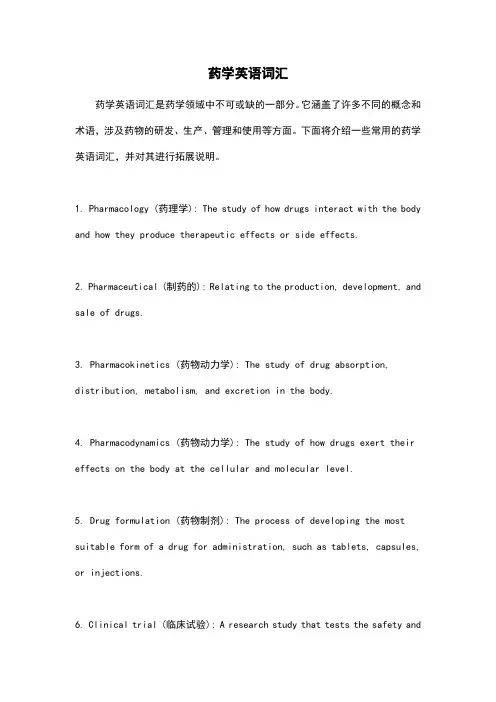
药学英语词汇药学英语词汇是药学领域中不可或缺的一部分。
它涵盖了许多不同的概念和术语,涉及药物的研发、生产、管理和使用等方面。
下面将介绍一些常用的药学英语词汇,并对其进行拓展说明。
1. Pharmacology (药理学): The study of how drugs interact with the body and how they produce therapeutic effects or side effects.2. Pharmaceutical (制药的): Relating to the production, development, and sale of drugs.3. Pharmacokinetics (药物动力学): The study of drug absorption, distribution, metabolism, and excretion in the body.4. Pharmacodynamics (药物动力学): The study of how drugs exert their effects on the body at the cellular and molecular level.5. Drug formulation (药物制剂): The process of developing the most suitable form of a drug for administration, such as tablets, capsules, or injections.6. Clinical trial (临床试验): A research study that tests the safety andeffectiveness of a new drug or treatment in humans.7. Drug interaction (药物相互作用): The effects that occur when two or more drugs are taken together, which can alter their individual therapeutic effects or cause adverse reactions.8. Adverse drug reaction (药物不良反应): Any harmful or unintended response to a drug, which may range from mild to severe.9. Pharmacist (药剂师): A healthcare professional who is knowledgeable about drugs, their uses, and their potential side effects, and who dispenses medications to patients.10. Prescription (处方): A written order from a healthcare provider fora specific medication, including dosage instructions and duration of treatment.11. Over-the-counter (OTC) (非处方药): Medications that can be purchased without a prescription, typically used to treat minor ailments and symptoms.12. Generic drug (仿制药): A medication that is equivalent to a brand-namedrug in terms of active ingredients, dosage form, strength, and route of administration, but is usually less expensive.13. Drug resistance (药物抗性): The ability of microorganisms or cancer cells to survive and multiply despite the presence of a drug, making the treatment less effective.14. Pharmacovigilance (药品监测): The science and activities related to the detection, assessment, understanding, and prevention of adverse effects or any other drug-related problems.15. Drug delivery system (药物输送系统): The technology or method by whicha drug is administered to the body, including oral, transdermal, inhalation, and intravenous routes.以上这些药学英语词汇不仅在医药领域中广泛使用,而且对于学习和理解药物的研发、使用和管理至关重要。

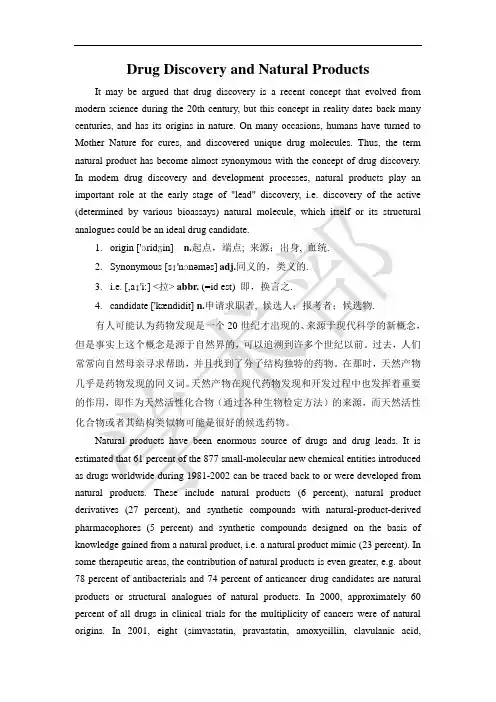
Drug Discovery and Natural Products It may be argued that drug discovery is a recent concept that evolved from modern science during the 20th century, but this concept in reality dates back many centuries, and has its origins in nature. On many occasions, humans have turned to Mother Nature for cures, and discovered unique drug molecules. Thus, the term natural product has become almost synonymous with the concept of drug discovery. In modem drug discovery and development processes, natural products play an important role at the early stage of "lead" discovery, i.e. discovery of the active (determined by various bioassays) natural molecule, which itself or its structural analogues could be an ideal drug candidate.1.origin ['ɔridʒin] n.起点,端点; 来源;出身, 血统.2.Synonymous [sɪ'nɔnəməs]adj.同义的,类义的.3.i.e. [,aɪ'i:] <拉> abbr. (=id est) 即,换言之.4.candidate ['kændidit] n.申请求职者, 候选人;报考者;候选物.有人可能认为药物发现是一个20世纪才出现的、来源于现代科学的新概念,但是事实上这个概念是源于自然界的,可以追溯到许多个世纪以前。
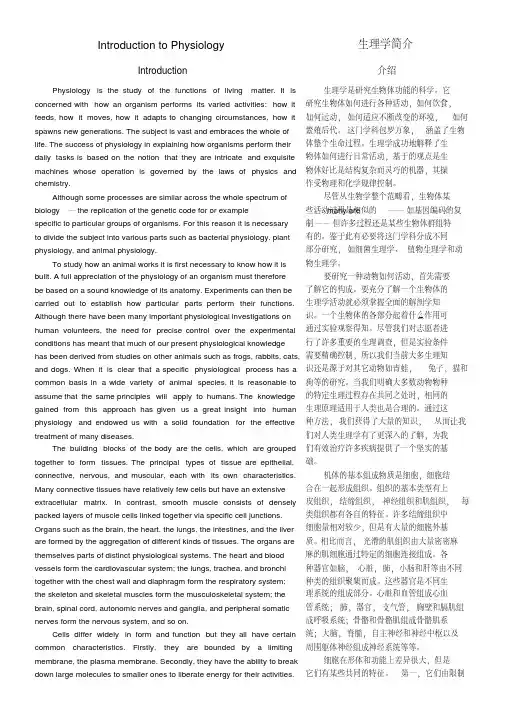
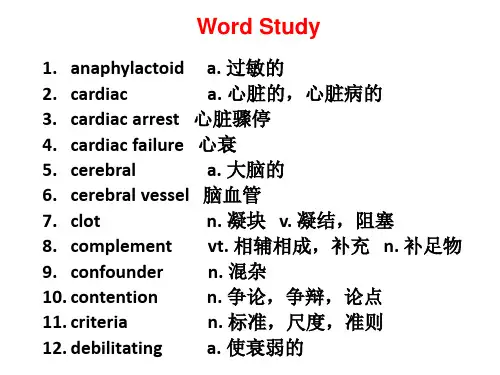
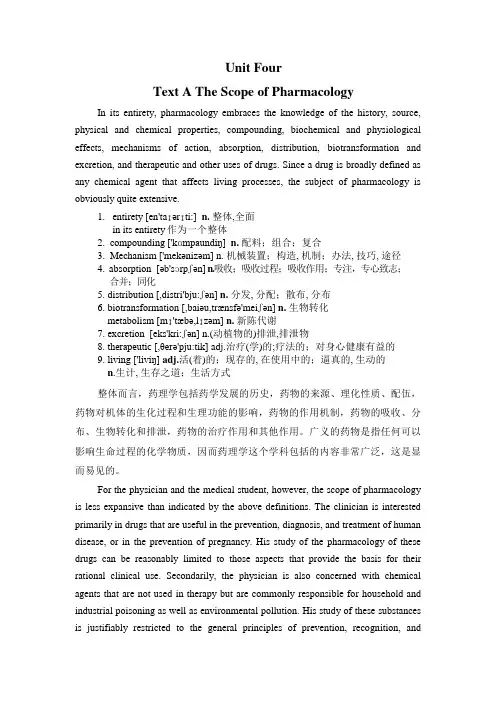
Unit FourText A The Scope of PharmacologyIn its entirety, pharmacology embraces the knowledge of the history, source, physical and chemical properties, compounding, biochemical and physiological effects, mechanisms of action, absorption, distribution, biotransformation and excretion, and therapeutic and other uses of drugs. Since a drug is broadly defined as any chemical agent that affects living processes, the subject of pharmacology is obviously quite extensive.1.entirety [en'taɪərɪti:] n.整体,全面in its entirety作为一个整体2. compounding ['kɑmpaundiŋ] n.配料;组合;复合3. Mechanism ['mekənizəm] n. 机械装置;构造, 机制;办法, 技巧, 途径4. absorption [əb'sɔrpʃən] n.吸收;吸收过程;吸收作用;专注,专心致志;合并;同化5. distribution [,distri'bju:ʃən] n.分发, 分配;散布, 分布6. biotransformation [,baiəu,trænsfə'meiʃən] n.生物转化metabolism [mɪ'tæbə,lɪzəm] n.新陈代谢7. excretion [eks'kri:ʃən] n.(动植物的)排泄,排泄物8. therapeutic [,θerə'pju:tik] adj.治疗(学)的;疗法的;对身心健康有益的9. living ['liviŋ]adj.活(着)的;现存的, 在使用中的;逼真的, 生动的n.生计, 生存之道;生活方式整体而言,药理学包括药学发展的历史,药物的来源、理化性质、配伍,药物对机体的生化过程和生理功能的影响,药物的作用机制,药物的吸收、分布、生物转化和排泄,药物的治疗作用和其他作用。
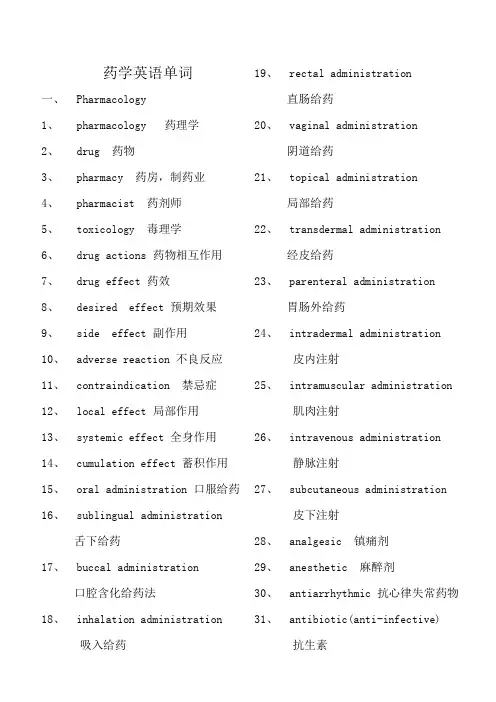
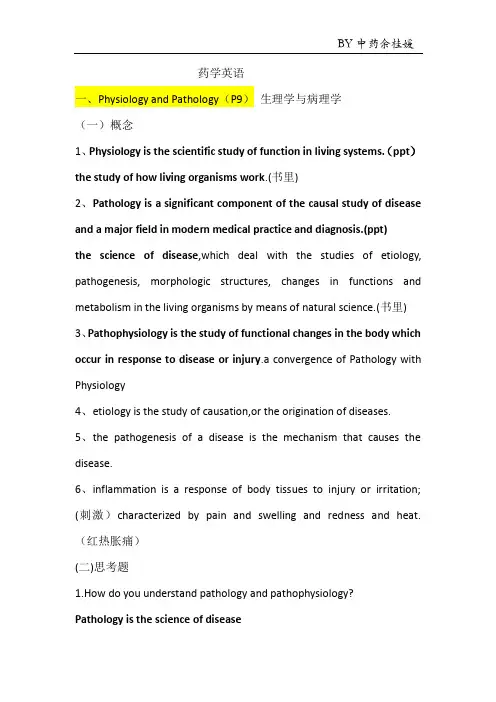
药学英语一、Physiology and Pathology(P9)生理学与病理学(一)概念1、Physiology is the scientific study of function in living systems.(ppt)the study of how living organisms work.(书里)2、Pathology is a significant component of the causal study of disease and a major field in modern medical practice and diagnosis.(ppt)the science of disease,which deal with the studies of etiology, pathogenesis, morphologic structures, changes in functions and metabolism in the living organisms by means of natural science.(书里) 3、Pathophysiology is the study of functional changes in the body which occur in response to disease or injury.a convergence of Pathology with Physiology4、etiology is the study of causation,or the origination of diseases.5、the pathogenesis of a disease is the mechanism that causes the disease.6、inflammation is a response of body tissues to injury or irritation; (刺激)characterized by pain and swelling and redness and heat. (红热胀痛)(二)思考题1.How do you understand pathology and pathophysiology?Pathology is the science of diseasePathophysiology is the study of functional changes in the body which occur in response to disease or injury.2. what is the difference between etiology and pathogenesis?Etiology is the study of causation, or the origination of diseases.the pathogenesis of a disease is the mechanism that causes the disease 3. Could you explain the symptoms and signs of a disease?symptoms of a disease(“症”): as certain biologic processes are encroached on(侵害) ,the patient begins to feel subjectively that something is wrong., These subjective feelings are called symptoms of disease.Symptoms are subjective and can be reported only by the patient to an observer.signs of a disease(“征”):when manifestations of the disease can be objectively identified by an observer, these are terms signs of the disease.4、what is the pathogenesis of tuberculosis?the pathogenesis of tuberculosis would include the mechanisms whereby the invasion of the body by tubercle bacillus ultimately leads to the observed abnormalitiesBiochemistry is the study of chemical processes in living organisms.二、Medicinal Chemistry药物化学(一)概念1、Medicinal chemistry(药物化学)is the science that deal with the discovery or design of new therapeutic chemicals and the development of these chemicals into useful medicine.2、Medicine(药品drug, pharmaceutics) is a compound that interacts with a biological system, and produces a biological response (ideally desired and positive)3、Therapeutic index(治疗指数)sure of the ratio of undesirable to desirable drug effects. Therapeutic index=LD50/ED50The larger the Therapeutic index, the greater the margin of safety of drug!4、LD50(半数致死量):the lethal dose for 50% of the test animals5、ED50(半数有效量):the effective dose that produces the maximum therapeutic effect in 50% of the test animals.6、Log P(脂水分配系数)is the base-ten logarithm of the partition coefficients (分配系数)7、Chirality(手征性): a molecule is considered chiral if there exists another molecule that is of identical composition ,but which is arranged in a non-superposable mirror image.8、Bioisosteres(生物电子等排体): are substituents or groups that havechemical or physical similarities ,and which produce broadly similar biological properties.9、Bioisosterism(生物电子等排性) is a lead modification approach that has been shown to be useful to attenuate toxicity (降低毒性),modify the activity of a lead (修饰活性)and may have a significant role in the alteration of metabolism of the lead.10、Prodrug(前药)is drug which is given (taken) in an inactive form. Once administered ,the prodrug is metabolized by the body into the biologically active compound.(二)知识点1、The difference of “good” and “bad” drugs:Depend on dosage and chronic exposure. and therapeutic index can be the measure of safety of drugs2、classification of drugsFour main groups:(1)B y biological effect---varied assortment of drugsanalgesics(止痛剂),anti-asthmatics(平喘药),antipsychotics(抗精神病药)etc.(2)B y chemical structure---common skeletonPenicillin (青霉素类),opiates(阿片类药物) etc.(3)B y target system(靶向系统)----affect a target system(synthesis, release, receptor)antihistamine (抗组胺药)etc.(4)B y target site of action(作用靶点)—target enzyme or receptor Anti-cholinesterase (抗胆碱酯酶)3、Medicinal chemistry involves:(1)synthesis (2)structure-activity relationships(SAR)(3)receptor interactions(4)absorption, distribution, metabolism and excretion (ADME)4、Medicinal chemistry cover 3 critical steps:● A discovery step●An optimization step● A development step5、important functional groups on drugs:(1)Alkanes&alkenes(烷烃和烯烃) (2)alcohol 醇(3)phenols 酚(4)ethers 醚(5)aromatic hydrocarbons 芳香化合物6、a drug usually has 3 names:(1)chemical (化学名)Mostly following rules by chemical abstracts service(CAS)One compound can only have one name(2)international non-proprietary names(INN,通用名)Convenient to remember ,needed when apply for registration, cannot be trade marked(商标)or patented(取得专利权)One compound can only have one name(3)commercial (商品名)Named by manufactures ,can be trade marked to protect the brand. One compound can have many different names7、prodrug strategies are used to overcome a variety of problems by:(1)Altering solubility 改变溶解度(2)Improving membrane permeability 提高细胞膜通透性(3)Slow release of the active agent 缓慢释放活性(4)Masking drug toxicity or side effects 掩蔽药物毒副作用三、Phytochemistry and Natural Products 天然药物化学和天然产物(一)概念1、Phytochemistry(天然药物化学)is in the strict sense of the study of phytochemicals, which are derived from plants. In a narrower sense the terms are often used to describe the large number of secondary metabolic compounds found in plants.2、Primary metabolites(初级代谢产物): compounds that are common to many types of organisms, that fulfill basic biologicalfunctions(e.g.respiration 呼吸,photosynthesis光合作用,DNA replication DNA复制)3、Secondary metabolites(次级代谢产物):compounds that are not essential to daily ,common metabolism of cells and individual organisms. Instead, these compounds are unique to certain taxa and fulfill secondary functions ,often involved in signaling between organisms (e.g.mate recognition配偶识别, chemical defense化学防御, chemotaxis 趋化作用)4、natural products: a natural product is a chemical compound or substance produced by a living organism found in nature.(Primary metabolites & Secondary metabolites)(二)知识点1、summary:●natural products are compounds synthesized by living organisms,usually organic molecules with 5-100 carbons●natural products can be primary or secondary metabolites●secondary metabolites are produced via enzymatic pathways fromprimary metabolic building-blocks2、how to get natural products?/the process to purify natural products?(1)Plant collection植物采集(2)Extraction萃取(3)Fractionation分馏(4)Isolation分离(5)Structural determination 结构测定(UV,IR,MS,NMR)3、Journals in Phytochemistry and Natural Products Chemistry:●Journal of Natural Products 天然产物杂志●Phytochemistry●Journal of Ethnopharmacology 民族药物学杂志●Planta Medica 天然药物学会志(欧洲)●Phytochemical Analysis 植物化学分析●Chemical &Pharmaceutical Bulletin 化学与药学通报(日本)Review journals 综述期刊●Natural Product Reports 天然产物报告●Phytochemistry Review四、biochemistry 生物化学1、What is the goal of biochemistry?The basic goal of the science of biochemistry is to determine how the collections of inanimate molecules (无生命的分子)that constitute living organisms interact with each other to maintain and perpetuate life.(延长生命)2、Macromolecules(生物大分子)that constitute living organisms include proteins, nucleic acid (DNA and RNA), and polysaccharides.3、20种氨基酸:1、丙氨酸Alanine/Ala/A2、半胱氨酸Cysteine/Cys/C3、天冬氨酸Asparticacid/ Asp /D4、谷氨酸Glutamic acid/Glu/E5、苯基丙氨酸Phenylalanine/Phe/F6、甘氨酸glycine/Gly/G7、组氨酸Histidine/His/H 8、异亮氨酸Isoleucine/Ile/I9、赖氨酸Lysine/Lys/K 10、亮氨酸Leucine/leu/L11、蛋氨酸Methionine/Met/M 12、天冬酰胺Asparagine/Asn/N 13、脯氨酸Procine/pro/P 14、谷氨酰胺Glutamine/Gln/Q 15、精氨酸Arginine/Arg/R 16、丝氨酸Serine/Ser/S17、苏氨酸Threonine/Thr/T 18、缬氨酸Valine/Val/V19、色氨酸Tryptophan/Try/W 20、酪氨酸Tyrosine/Tyr/Y五、Microbiology 微生物学1、Microbiology is the study of microscopic organisms such as bacteria, fungi, protozoa,virus and some types of algae, which encompass various sub-disciplines including virology, mycology, parasitology, bacteriology, and other branches.2、几位科学家的成就Bacteriology was found in the 19th century by Ferdinand CohnCohn was also the first to formulate the scheme for the taxonomic classification of bacterial and discover spores费迪南德∙科恩, Ferdinand Cohn德国博物学家和植物学家,以研究藻类、细菌和蕈类著称,被视为细菌学的创始者之一。
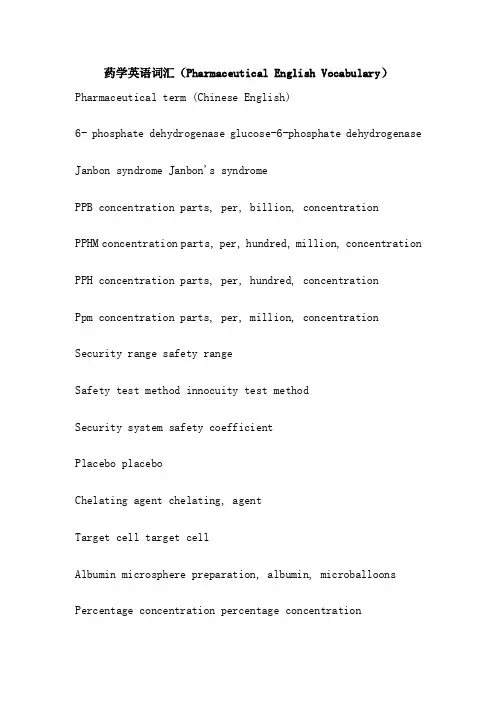
药学英语词汇(Pharmaceutical English Vocabulary)Pharmaceutical term (Chinese English)6- phosphate dehydrogenase glucose-6-phosphate dehydrogenase Janbon syndrome Janbon's syndromePPB concentration parts, per, billion, concentrationPPHM concentration parts, per, hundred, million, concentration PPH concentration parts, per, hundred, concentrationPpm concentration parts, per, million, concentration Security range safety rangeSafety test method innocuity test methodSecurity system safety coefficientPlacebo placeboChelating agent chelating, agentTarget cell target cellAlbumin microsphere preparation, albumin, microballoons Percentage concentration percentage concentrationSemisynthetic antibiotic, semisynthetic, antibioticsHapten hapteneThe median lethal dose was half, lethal, dose; median, lethal, dose, LD50;Half-life half-life period; half life timeCoated tablets coated, tabletFilm clothing film-coatingSaturated solution saturated, solutionBecquerel BecquerelPassive immunity, passive, immunityPassive transport of passive transportDisintegration rate disintegrationDisintegrating agent disintegrantsEssential amino acids essential, aminoacidEssential fatty acids essential, fatty, acidAllergy; allergy; allergic; reactionSurface active surface activitySurface tension surface, tensionGamma ray gamma raysComplement complementComplement system complement, systemAdverse reactions were adverse, reactionIncomplete antigen incomplete, antigenLiniment linimentsLong term toxicity test long, term, toxicity, test Long acting preparations prolonged, action, preparation The hepatic circulation enterohepatic, circulationEnteric controlled release tablets enteric, controlled, release, tabletsEnteric coated enteric coatingPrescription prescription; recipePenetration enhancer penetration, enhancersMagnetic controlled release preparations magnetic, controlled, release, dosage, formMagnetic drug formulations magnetic, medicinal, preparationsMacromolecule macromoleculeMonoclonal antibody monoclonal antibodyCholinesterase cholinesteraseEquivalent equivalent weightEquivalent law equivalent lawEquivalent concentration normalityEquivalent solution normal, solutionIsotonic solution isotonic, solutionOligosaccharide oligosaccharidesLow density lipoprotein low, density, lipoproteinTitration titrationTitration curve titration curveDropping pill pillTransmitter transmitterElectrolytic electrolyzationElectrolyte electrolyteTincture tinctureDirected drug formulations directed, pharmaceutical, preparationsToxicology toxicologyToxicity was toxic, response, toxic, reaction;Short-term carcinogenicity experiments short, term, carcinogenic, testFor the treatment of etiological treatmentEnantiomer antipodeSymptomatic treatment with symptomatic treatmentMultifunctional enzyme multifunctional enzymeMulti dose administration of multiple, dose, and AdministrationPolysaccharide polyosePolypeptide polypeptideCatecholamine catecholamineDouble infection, superinfectionFermentation fermentationLegal prescription Official FormulaAromatic compound aromatic, compoundRadiation toxicology, radiotoxicology Radiopharmaceutical radiopharmaceuticsNon essential amino acids non-essential, amino, acid Non depolarizing muscle relaxant nondepolarizer Molecular disease molecular diseaseMolecular solution molecular, solutionMolecular biology, molecular, biologyMolecular pharmacology, molecular, pharmacology Prosthetic group prosthetic groupExcipient excipientsCoenzyme coenzymeSide effects side, effectAdditive additiveDesiccant desiccant; drying agentLiver first pass effect first, pass, effect, of, heparReceptor receptorGao Min's sex hyperreactivityIndividual differences in individual, differences, individual, variation;人工免疫人工免疫人种药理学生物学日内瓦命名法日内瓦命名溶剂溶剂;溶剂溶解溶解;溶解溶菌酶溶菌酶溶血溶血溶质溶质三羧酸循环三羧酸循环杀菌活性杀菌活性杀菌作用杀菌效果身体依赖性身体依赖性神经毒素神经毒素肾上腺素能神经肾上腺素能神经肾上腺素能受体肾上腺素能受体渗透压渗透压生长曲线生长曲线生物胺生物胺生物半衰期生物半衰期生物化学生化生物碱生物碱生物利用度生物利用度生物统计学生物;生物生物药剂学生物制药生物制品生物制品生药药材时辰药理学时辰药理学时间感受性时辰感受性时间治疗时辰时效关系时间效应关系时值时值时值;时滞滞后时间世界卫生组织世界卫生组织;谁噬菌体噬菌体收敛药涩手性药物手性药物首过效应首过效应受体受体受体激动剂受体兴奋剂受体拮抗剂受体拮抗剂双盲法双盲法水解(作用)水解糖异生作用糖异生体表面积体表面积体积比浓度体积浓度体液体液体液免疫体液免疫天然抗体天然抗体天然抗原天然抗原天然免疫自然免疫天然药物药材;天然药物调剂学配药药房同位素同位素突变突变吞噬作用吞噬外毒素外毒素外消旋体总状花序完全抗原完全抗原王水王水;王水微粒体酶微粒体酶微量元素微量元素稳态血药浓度稳态血浆浓度物理药剂学物理药剂学吸入法吸入吸收速率常数吸收速率常数细胞免疫细胞免疫腺苷磷酸磷酸腺苷限制性剧药限制性剧药相对给药间隔相对剂量间隔相加作用加性效应;此外向靶给药靶向给药消除速率常数消除速率常数效价效力效价单位效价单位效价强度效力效应效应效应器效应效应物效应协定处方密码处方协同作用增效兴奋性兴奋序贯设计序贯设计悬浮液悬浮选择性选择性血管内给药血管内给药血管外给药血管外给药血浆等离子体血浆代用液血浆代用品血浆蛋白结合率血浆蛋白结合率血脑屏障血脑屏障血清血清血容量扩充剂血容量扩充剂血药浓度血药浓度血液凝固凝血血液制品血液制品亚急性中毒亚急性中毒;亚急性中毒亚硝酸盐中毒亚硝酸盐中毒眼用膜剂眼插入药-药物时间时半对数曲线半对数曲线药-时曲线药时曲线药峰浓度峰值药物浓度药峰时间峰值时间的药物药剂等效性制药等价药剂学药剂学药理学药理学药敏试验药物敏感试验药品负责期配发药品质量保证的生产日期药品管理法药品管理法药品批号药品批号药品使用期限制日期后生产使用的药物药品有效期截止日期;到期日期药品质量标准药品标准药物代谢药物代谢药物代谢酶药物代谢酶药物的体内过程药物的体内过程药物动力学模型动力学模型药物反应药物反应药物分布药物分布药物分析药物分析药物化学药物化学药物排泄药物排泄药物吸收药物吸收药物相互作用药物相互作用药物消除药物消除药物蓄积药物积累药物学药理学;中药药物遗传学遗传药理学药效动力学药效学药源性疾病药源性疾病乙酰胆碱乙酰胆碱乙酰胆碱乙酰胆碱酯酶乙酰胆碱酯酶抑菌活性抑菌活性抑菌作用抑菌作用异构酶异构酶营养素养分硬膏剂石膏有效半衰期有效制止有效率有效率有效浓度有效浓度右旋糖葡萄糖右旋体右旋形式阈剂量阈剂量载体载体皂甙皂苷脂质体脂质体直肠给药直肠给药直线相关线性相关纸型片剂纸型片剂致癌实验致癌试验致癌物致癌物致畸试验致畸试验致畸物致畸致敏试验致敏试验致敏作用敏化致死量致死剂量;致死剂量制剂制备药剂学制剂学技术制药化学药物化学治疗等效(值)治疗等效治疗量治疗剂量治疗药物临测治疗药物监测;监测治疗指数治疗指数TI治疗作用治疗作用中毒中毒;中毒中华人民共和国卫生部药品标准对中华人民共和国卫生部药品标准中间体中间助滤剂助滤剂助溶剂助溶剂助悬剂悬浮剂自身免疫自身免疫组胺组胺最大耐受剂量最大耐受剂量;LDO最大无作用剂量最大无作用剂量;江户最小显著差数最小显著差异最小有效量最小有效剂量最小致死剂量最小致死剂量;MLD左旋糖果糖左旋体左旋形式佐剂佐剂。
药学英语单词一、Pharmacology1、pharmacology 药理学2、drug 药物3、pharmacy 药房,制药业4、pharmacist 药剂师5、toxicology 毒理学6、drug actions 药物相互作用7、drug effect 药效8、desired effect 预期效果9、side effect 副作用10、adverse reaction 不良反应11、contraindication 禁忌症12、local effect 局部作用13、systemic effect 全身作用14、cumulation effect 蓄积作用15、oral administration 口服给药16、sublingual administration舌下给药17、buccal administration口腔含化给药法18、inhalation administration吸入给药19、rectal administration直肠给药20、vaginal administration阴道给药21、topical administration局部给药22、transdermal administration经皮给药23、parenteral administration胃肠外给药24、intradermal administration皮内注射25、intramuscular administration肌肉注射26、intravenous administration静脉注射27、subcutaneous administration皮下注射28、analgesic 镇痛剂29、anesthetic 麻醉剂30、antiarrhythmic 抗心律失常药物31、antibiotic(anti-infective)抗生素32、anticoagulant 抗凝剂33、anticonvulsant 抗惊厥剂34、antidepressant 抗抑郁药35、antidiabetic 抗糖尿病36、antidiarrheal 止泻药37、antidiuretic 抗利尿剂38、antiemetic 止吐剂39、antifungal 抗真菌剂40、antihistamine 抗组胺药41、antihypertensive 降压药42、anti-inflammatory 抗炎药43、antineoplastic 抗肿瘤药44、antitussive 镇咳药45、antiulcer agent 抗溃疡药46、antiviral agent 抗病毒剂47、beta blocker β-受体阻滞药48、bronchodilator 支气管扩张药49、hormone 荷尔蒙50、hypnotic 安眠药51、immunosuppressant 免疫抑制剂52、laxative 泻药53、lipid-lowering agent 降脂剂54、sedative 镇静剂,止痛药55、vitamin 维生素56、institute for safe medicationspractices (ISMP)安全药物试验研究所57、milliequivalent(mEq)毫当量二、R&D of New Drugs1、Acute 急性的2、Leukemia 白血病3、Chronic 慢性的4、Agonist 激动剂5、Antagonist 拮抗剂6、New chemical entity新化学实体7、Lead compound先导化合物8、Drug candidate候选药物9、In-vitro 在试管内10、In vivo 有活力的11、Synthesize 合成12、Supervise 监督,管理13、Authorize 批准,认可14、Double-blind 双盲15、Placebo 安慰剂/无效对照剂16、Indication 适应症17、Submission 投降,提交,服从18、Evolution of a new drug新药发展的历程19、drug development strategies新药研发的策略20、serendipity 意外发现,运气21、intuition 直觉22、roulette 轮盘赌23、staphylococci 葡萄状球菌24、penicillin 青霉素25、podophyllotoxin 足叶草毒素26、vincristine 长春新碱27、taxol 紫杉醇28、camptothecin 喜树碱29、molecular roulette 分子转轮30、minor structural changesin existing agents现有药物分子结构的细微修正31、programmed basic researchwith synthesis of specificchemicals对特定化合物的合成而制定的基础研究32、clinical observation of drugaction in practice 使用中药物作用的临床观察33、berberine 小檗碱34、experimental pharmacology实验药理学35、subcellular particles 亚细胞粒子36、isolated tissue 离体组织37、perfused organs 灌注器官38、haematological 血液学的39、teratogenic 致畸的40、mutagenicity 诱变41、carcinogenicity 致癌性42、toxicological assessment毒物学监定43、rationale 基本原理三、drug dependence1、withdrawal 撤退,收回2、opiate 鸦片试剂3、cocaine 可卡因4、amphetamine 苯丙胺5、alcohol酒精6、barbiturate 巴比妥类7、cannabis 大麻8、volatile solvents 挥发性气体9、psychic dependence精神成瘾性10、physical dependence身体成瘾性11、curiosity and wanting tobelong好奇和归属感12、psychiatric 精神病学的13、make-up 化妆品14、availability 可用性15、heroin(diacetylmorphine)咖啡因(二乙酰吗啡)16、restlessness 躁动不安17、distress 悲痛18、nausea 恶心,晕船19、pyrexial 发热的,发烧的20、the possibility of over dosage可能吸食过量21、the frequent occurrenceof sepsis常发生败血症22、baby born to an addict成瘾者的小孩23、go to any length to想尽一切办法24、management 戒毒25、addicts must be registered成瘾者一定要登记在册26、methadone 美沙酮27、clonidine 可乐定28、the nasal septum 鼻隔膜29、appetite suppressor食欲抑制剂30、powerful stimulant 强效兴奋剂31、mental disturbances 精神紊乱32、hallucination 幻觉33、epileptic fits 癫痫发作34、resin 树脂,松香35、volatile solvent 挥发性溶剂36、euphoria 精神欢快37、detoxification and medicallymanaged withdrawal去毒及医疗辅助下的撤去毒品38、long-term residential treatment长期居家治疗39、short-term residential programs短期居家治疗40、outpatient treatment门诊治疗41、individualized drug counseling个性化毒品咨询42、group counseling集体咨询。
(完整版)药学英语专业词汇一、药物分类及命名1. 抗生素(Antibiotics)青霉素(Penicillin)头孢菌素(Cephalosporins)大环内酯类(Macrolides)2. 抗病毒药物(Antiviral Drugs)抗流感病毒药物(Antiviral for Influenza)抗艾滋病病毒药物(Antiviral for HIV)3. 抗肿瘤药物(Anticancer Drugs)化疗药物(Chemotherapeutic Agents)靶向治疗药物(Targeted Therapy Drugs)4. 心血管系统药物(Cardiovascular Drugs)抗高血压药物(Antihypertensive Drugs)抗心绞痛药物(Antianginal Drugs)抗心律失常药物(Antiarrhythmic Drugs)5. 消化系统药物(Gastrointestinal Drugs)抗胃溃疡药物(Antigastric Ulcer Drugs)止泻药物(Antidiarrheal Drugs)泻药(Laxatives)6. 中枢神经系统药物(Central Nervous System Drugs)抗抑郁药物(Antidepressants)抗精神病药物(Antipsychotic Drugs)镇痛药物(Analgesics)二、药物剂型及给药途径1. 剂型(Dosage Forms)片剂(Tablets)胶囊(Capsules)注射剂(Injections)2. 给药途径(Routes of Administration)口服(Oral)肌内注射(Intramuscular)静脉注射(Intravenous)三、药物作用及不良反应1. 药物作用(Pharmacological Actions)抗菌作用(Antibacterial Action)抗病毒作用(Antiviral Action)镇痛作用(Analgesic Action)2. 不良反应(Adverse Reactions)过敏反应(Allergic Reactions)胃肠道反应(Gastrointestinal Reactions)肝脏毒性(Hepatotoxicity)四、药学专业英语词汇1. 药理学(Pharmacology)药物代谢(Drug Metabolism)药物动力学(Pharmacokinetics)药效学(Pharmacodynamics)2. 药剂学(Pharmaceutics)制剂工艺(Preparation Technology)药物稳定性(Drug Stability)药物质量控制(Drug Quality Control)3. 药物化学(Medicinal Chemistry)药物合成(Drug Synthesis)药物结构(Drug Structure)药物设计(Drug Design)本文档旨在帮助药学专业学生和从业者掌握药学英语专业词汇,提高专业英语水平,为学术交流和临床实践提供便利。
药学英语一、Physiology and Pathology(P9)生理学与病理学(一)概念1、Physiology is the scientific study of function in living systems.(ppt)the study of how living organisms work.(书里)2、Pathology is a significant component of the causal study of disease and a major field in modern medical practice and diagnosis.(ppt)the science of disease,which deal with the studies of etiology, pathogenesis, morphologic structures, changes in functions and metabolism in the living organisms by means of natural science.(书里) 3、Pathophysiology is the study of functional changes in the body which occur in response to disease or injury.a convergence of Pathology with Physiology4、etiology is the study of causation,or the origination of diseases.5、the pathogenesis of a disease is the mechanism that causes the disease.6、inflammation is a response of body tissues to injury or irritation; (刺激)characterized by pain and swelling and redness and heat. (红热胀痛)(二)思考题1.How do you understand pathology and pathophysiology?Pathology is the science of diseasePathophysiology is the study of functional changes in the body which occur in response to disease or injury.2. what is the difference between etiology and pathogenesis?Etiology is the study of causation, or the origination of diseases.the pathogenesis of a disease is the mechanism that causes the disease 3. Could you explain the symptoms and signs of a disease?symptoms of a disease(“症”): as certain biologic processes are encroached on(侵害) ,the patient begins to feel subjectively that something is wrong., These subjective feelings are called symptoms of disease.Symptoms are subjective and can be reported only by the patient to an observer.signs of a disease(“征”):when manifestations of the disease can be objectively identified by an observer, these are terms signs of the disease.4、what is the pathogenesis of tuberculosis?the pathogenesis of tuberculosis would include the mechanisms whereby the invasion of the body by tubercle bacillus ultimately leads to the observed abnormalitiesBiochemistry is the study of chemical processes in living organisms.二、Medicinal Chemistry药物化学(一)概念1、Medicinal chemistry(药物化学)is the science that deal with the discovery or design of new therapeutic chemicals and the development of these chemicals into useful medicine.2、Medicine(药品drug, pharmaceutics) is a compound that interacts with a biological system, and produces a biological response (ideally desired and positive)3、Therapeutic index(治疗指数)sure of the ratio of undesirable to desirable drug effects. Therapeutic index=LD50/ED50The larger the Therapeutic index, the greater the margin of safety of drug!4、LD50(半数致死量):the lethal dose for 50% of the test animals5、ED50(半数有效量):the effective dose that produces the maximum therapeutic effect in 50% of the test animals.6、Log P(脂水分配系数)is the base-ten logarithm of the partition coefficients (分配系数)7、Chirality(手征性): a molecule is considered chiral if there exists another molecule that is of identical composition ,but which is arranged in a non-superposable mirror image.8、Bioisosteres(生物电子等排体): are substituents or groups that havechemical or physical similarities ,and which produce broadly similar biological properties.9、Bioisosterism(生物电子等排性) is a lead modification approach that has been shown to be useful to attenuate toxicity (降低毒性),modify the activity of a lead (修饰活性)and may have a significant role in the alteration of metabolism of the lead.10、Prodrug(前药)is drug which is given (taken) in an inactive form. Once administered ,the prodrug is metabolized by the body into the biologically active compound.(二)知识点1、The difference of “good” and “bad” drugs:Depend on dosage and chronic exposure. and therapeutic index can be the measure of safety of drugs2、classification of drugsFour main groups:(1)B y biological effect---varied assortment of drugsanalgesics(止痛剂),anti-asthmatics(平喘药),antipsychotics(抗精神病药)etc.(2)B y chemical structure---common skeletonPenicillin (青霉素类),opiates(阿片类药物) etc.(3)B y target system(靶向系统)----affect a target system(synthesis, release, receptor)antihistamine (抗组胺药)etc.(4)B y target site of action(作用靶点)—target enzyme or receptor Anti-cholinesterase (抗胆碱酯酶)3、Medicinal chemistry involves:(1)synthesis (2)structure-activity relationships(SAR)(3)receptor interactions(4)absorption, distribution, metabolism and excretion (ADME)4、Medicinal chemistry cover 3 critical steps:● A discovery step●An optimization step● A development step5、important functional groups on drugs:(1)Alkanes&alkenes(烷烃和烯烃) (2)alcohol 醇(3)phenols 酚(4)ethers 醚(5)aromatic hydrocarbons 芳香化合物6、a drug usually has 3 names:(1)chemical (化学名)Mostly following rules by chemical abstracts service(CAS)One compound can only have one name(2)international non-proprietary names(INN,通用名)Convenient to remember ,needed when apply for registration, cannot be trade marked(商标)or patented(取得专利权)One compound can only have one name(3)commercial (商品名)Named by manufactures ,can be trade marked to protect the brand. One compound can have many different names7、prodrug strategies are used to overcome a variety of problems by:(1)Altering solubility 改变溶解度(2)Improving membrane permeability 提高细胞膜通透性(3)Slow release of the active agent 缓慢释放活性(4)Masking drug toxicity or side effects 掩蔽药物毒副作用三、Phytochemistry and Natural Products 天然药物化学和天然产物(一)概念1、Phytochemistry(天然药物化学)is in the strict sense of the study of phytochemicals, which are derived from plants. In a narrower sense the terms are often used to describe the large number of secondary metabolic compounds found in plants.2、Primary metabolites(初级代谢产物): compounds that are common to many types of organisms, that fulfill basic biologicalfunctions(e.g.respiration 呼吸,photosynthesis光合作用,DNA replication DNA复制)3、Secondary metabolites(次级代谢产物):compounds that are not essential to daily ,common metabolism of cells and individual organisms. Instead, these compounds are unique to certain taxa and fulfill secondary functions ,often involved in signaling between organisms (e.g.mate recognition配偶识别, chemical defense化学防御, chemotaxis 趋化作用)4、natural products: a natural product is a chemical compound or substance produced by a living organism found in nature.(Primary metabolites & Secondary metabolites)(二)知识点1、summary:●natural products are compounds synthesized by living organisms,usually organic molecules with 5-100 carbons●natural products can be primary or secondary metabolites●secondary metabolites are produced via enzymatic pathways fromprimary metabolic building-blocks2、how to get natural products?/the process to purify natural products?(1)Plant collection植物采集(2)Extraction萃取(3)Fractionation分馏(4)Isolation分离(5)Structural determination 结构测定(UV,IR,MS,NMR)3、Journals in Phytochemistry and Natural Products Chemistry:●Journal of Natural Products 天然产物杂志●Phytochemistry●Journal of Ethnopharmacology 民族药物学杂志●Planta Medica 天然药物学会志(欧洲)●Phytochemical Analysis 植物化学分析●Chemical &Pharmaceutical Bulletin 化学与药学通报(日本)Review journals 综述期刊●Natural Product Reports 天然产物报告●Phytochemistry Review四、biochemistry 生物化学1、What is the goal of biochemistry?The basic goal of the science of biochemistry is to determine how the collections of inanimate molecules (无生命的分子)that constitute living organisms interact with each other to maintain and perpetuate life.(延长生命)2、Macromolecules(生物大分子)that constitute living organisms include proteins, nucleic acid (DNA and RNA), and polysaccharides.3、20种氨基酸:1、丙氨酸Alanine/Ala/A2、半胱氨酸Cysteine/Cys/C3、天冬氨酸Asparticacid/ Asp /D4、谷氨酸Glutamic acid/Glu/E5、苯基丙氨酸Phenylalanine/Phe/F6、甘氨酸glycine/Gly/G7、组氨酸Histidine/His/H 8、异亮氨酸Isoleucine/Ile/I9、赖氨酸Lysine/Lys/K 10、亮氨酸Leucine/leu/L11、蛋氨酸Methionine/Met/M 12、天冬酰胺Asparagine/Asn/N 13、脯氨酸Procine/pro/P 14、谷氨酰胺Glutamine/Gln/Q 15、精氨酸Arginine/Arg/R 16、丝氨酸Serine/Ser/S17、苏氨酸Threonine/Thr/T 18、缬氨酸Valine/Val/V19、色氨酸Tryptophan/Try/W 20、酪氨酸Tyrosine/Tyr/Y五、Microbiology 微生物学1、Microbiology is the study of microscopic organisms such as bacteria, fungi, protozoa,virus and some types of algae, which encompass various sub-disciplines including virology, mycology, parasitology, bacteriology, and other branches.2、几位科学家的成就Bacteriology was found in the 19th century by Ferdinand CohnCohn was also the first to formulate the scheme for the taxonomic classification of bacterial and discover spores费迪南德∙科恩, Ferdinand Cohn德国博物学家和植物学家,以研究藻类、细菌和蕈类著称,被视为细菌学的创始者之一。
药学英语词汇汇总药学英语词汇是药学领域中使用最广泛的术语和词汇。
以下是一些常见的药学英语词汇及其含义:1、Pharmaceutical:药物的,药学的2、Drug:药物,药品3、Medicine:药物,医学4、Dosage:剂量,配药5、Dose:剂量,投药量6、Route:给药途径7、Administration:给药,投药8、Inhalation:吸入9、Oral:口服的10、Rectal:直肠的11、Topical:局部的,外用的12、Transdermal:透皮吸收的13、Intravenous:静脉注射的14、Intramuscular:肌肉注射的15、Subcutaneous:皮下注射的16、Administration:(给药的)方式,(药物的)投药途径17、Controlled-release dosage form:控释剂型18、Drug interaction:药物相互作用19、Drug resistance:药物耐受性,耐药性20、Toxicity:毒性21、Side effect:副作用22、Overdose:用药过量23、Drug tolerance:药物耐受性,耐药性24、Pharmacokinetics:药物代谢动力学25、Pharmacodynamics:药效学,药物作用动力学26、Pharmacologist:药理学家,药学家27、Pharmacy technician:药房技术员,药剂师助理28、Prescription:处方,药方29、Non-prescription drug:非处方药30、Generic drug:非专利药品,仿制药31、Brand-name drug:品牌药,专利药品32、Formulation:配方,制剂33、Dosage form:剂量形式,剂型在高中英语的学习过程中,词汇的学习是至关重要的环节。
拥有足够的词汇量不仅可以提高阅读理解能力,还能增强写作和口语的表达。
药学英语试题及答案一、选择题(每题2分,共20分)1. The term "pharmacology" refers to the study of:A. The origin of drugsB. The effects of drugs on the bodyC. The synthesis of drugsD. The distribution of drugs答案:B2. Which of the following is not a route of drug administration?A. OralB. IntravenousC. InhalationD. Electrolysis答案:D3. The half-life of a drug is the time it takes for the concentration of the drug in the body to:A. DoubleB. TripleC. QuadrupleD. Decrease by half答案:D4. Which of the following is a common side effect of antibiotics?A. Dry mouthB. DiarrheaC. InsomniaD. All of the above答案:B5. The abbreviation "IV" stands for:A. IntravenousB. IntramuscularC. IntraperitonealD. Intradermal答案:A6. The term "bioavailability" refers to the:A. Percentage of a drug that is absorbed into the systemic circulationB. Percentage of a drug that is excreted unchangedC. Percentage of a drug that is metabolized in the liverD. Percentage of a drug that is stored in fat tissues答案:A7. Which of the following is a type of drug interaction?A. SynergismB. AntagonismC. PotentiationD. All of the above答案:D8. The therapeutic index of a drug is a measure of its:A. EfficacyB. SafetyC. Cost-effectivenessD. Taste答案:B9. The term "prodrug" refers to a drug that:A. Is already active when administeredB. Requires metabolic activation to become activeC. Is a combination of two drugsD. Is a drug that has been discontinued答案:B10. Which of the following is a method for enhancing drug solubility?A. Salt formationB. Coating with a polymerC. MicronizationD. All of the above答案:D二、填空题(每空1分,共20分)1. The ________ of a drug refers to its ability to reach the site of action in the body.答案:pharmacokinetics2. A drug that is administered as a liquid and is intended to be swallowed is called a ________.答案:solution3. The ________ of a drug is the maximum amount that can be given without causing harmful effects.答案:therapeutic dose4. A drug that is used to treat a specific disease or condition is called a ________.答案:therapeutic agent5. The ________ of a drug is the minimum amount that will produce a therapeutic effect.答案:therapeutic dose6. A drug that is used to prevent a disease or condition is called a ________.答案:prophylactic agent7. The ________ of a drug is the study of its effects on biological systems.答案:pharmacodynamics8. A drug that is used to alleviate symptoms without treating the underlying cause is called a ________.答案:symptomatic agent9. The ________ of a drug is the process by which it isremoved from the body.答案:elimination10. A drug that is used to treat a wide range of conditionsis called a ________.答案:broad-spectrum agent三、简答题(每题10分,共40分)1. Explain the difference between a generic drug and a brand-name drug.答案:A generic drug is a copy of a brand-name drug that has the same dosage form, safety, strength, quality, performance characteristics, and intended use. A brand-name drug is the original version of a drug that has beendeveloped by a pharmaceutical company and is protected by a patent.2. What are the factors that can influence the absorption ofa drug?答案:Factors that can influence the absorption of a drug include the route of administration, the formulation of the drug, the presence of food in the stomach, the pH of the gastrointestinal tract, and the individual's health status.3. Describe the process of drug metabolism.答案:Drug metabolism is the process by which the body breaks down and eliminates drugs. It typically involves two phases: Phase I reactions, which involve oxidation, reduction, or hydrolysis to make the drug more polar, and Phase。
药学英语知识点归纳药学英语是指与药学相关的英语知识。
药学是研究药物的性质、合成、制备、分离、鉴定、药效、药代动力学以及其应用和临床评价的一门科学。
药学英语作为专业英语的一部分,主要包括药学常用词汇、句子结构、专业写作和专业交流等方面的内容。
1. 药学常用词汇在药学英语中,有许多常用的词汇需要掌握。
例如:- drug:药物- medicine:医学;药;医药- dosage:剂量- prescription:处方- pharmacy:药房- pharmaceutical:制药的- efficacy:药效- adverse effect:不良反应- overdose:过量服用- side effect:副作用- contraindication:禁忌症- drug interaction:药物相互作用2. 句子结构掌握药学英语的句子结构对于正确理解和表达药学领域的内容非常重要。
以下是一些常见的句子结构:- 简单句:包括主语、谓语和宾语,用来陈述一个简单的事实或观点。
例如:“The drug is effective for treating hypertension.”- 复合句:包括一个主句和一个或多个从句,用来表达复杂的观点、条件、原因等。
例如:“If the patient has a history of allergic reactions, the drug should be avoided.”- 并列连词:用于连接两个相对 ** 的句子或短语。
例如:“The drug is effective, but it may cause side effects.”- 介词短语:用于描述药物的用法、途径和目的等。
例如:“The medication sho uld be taken before meals.”- 被动语态:用于强调动作的承受者而不是执行者。
例如:“The drug is widely used in clinical practice.”3. 专业写作在药学领域,专业写作是一种常见的沟通方式。